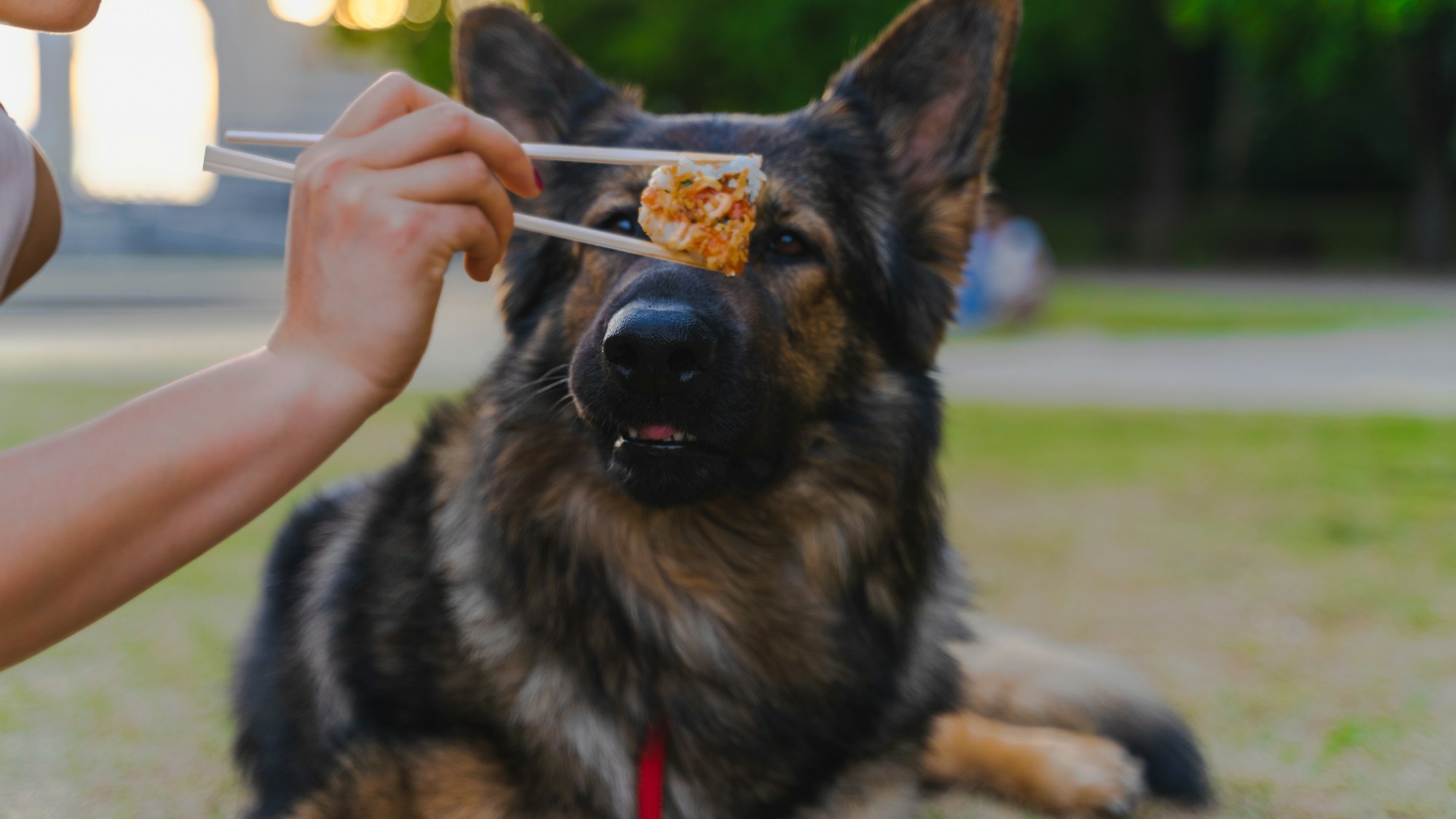Have you ever wondered if dogs can taste spicy food? As a dog owner, you may have noticed your furry friend's reactions when they accidentally consume something with a kick of heat. In this article, we will delve into the fascinating world of a dog's taste buds and explore whether they can truly perceive the fiery sensation of spicy flavors. So, let's embark on this flavorful journey and uncover the truth about whether dogs can taste spicy.
To comprehend whether dogs can taste spicy, it's crucial to understand their taste system. While humans possess around 9,000 taste buds, dogs have significantly fewer, averaging around 1,700. These taste buds are located on the tongue, roof of the mouth, and back of the throat.

The Science Behind Spiciness
Spiciness is primarily attributed to a compound called capsaicin, commonly found in chili peppers. This compound binds to receptors in human taste buds, triggering the sensation of heat and spice. But what about dogs?
Do Dogs Have Receptors for Spiciness?
When it comes to the ability to taste spicy flavors, dogs differ from humans. Humans have taste buds that can detect the sensation of spiciness, thanks to specific receptors for capsaicin, the compound responsible for the heat in spicy food. However, dogs have a different set of taste receptors, and they do not possess the receptors to perceive spiciness in the same way we do.

Factors Influencing Canine Taste Perception
Although dogs lack the specific receptors for spiciness, their taste perception is influenced by various factors. Genetics plays a role in determining a dog's taste preferences. Additionally, individual differences and breed variations can affect how dogs perceive and enjoy different flavors.
When it comes to taste, dogs have taste buds for sweet, sour, salty, and bitter flavors, but their taste receptors for each of these flavors may not be as developed or sensitive as those of humans. This is why dogs often prefer foods with stronger smells and flavors, which are more enticing to their keen sense of smell.
The preferences for certain flavors can also be influenced by their evolutionary history and dietary needs. Dogs, being descendants of wolves, have a preference for meaty and savory flavors. This preference is rooted in their carnivorous nature and the need for protein-rich diets.
Furthermore, a dog's upbringing and exposure to different tastes during their formative stages can also shape their taste preferences. Dogs that have been exposed to a wide variety of flavors early on may be more receptive to new tastes later in life.
It's important to note that individual dogs may have unique taste preferences and sensitivities. Some dogs may be more adventurous and open to trying new flavors, while others may be more selective or even finicky eaters.
Understanding these factors can help dog owners choose appropriate and appealing flavors when selecting food and treats for their furry companions. By providing a balanced and nutritious diet that aligns with a dog's dietary needs and preferences, owners can ensure their pets' overall well-being and enjoyment of mealtimes.
Observing Dogs' Reactions to Spicy Food

If you've ever given your dog a taste of something spicy, you may have noticed their immediate reaction. Dogs have a sensitive sense of taste, and when they encounter spicy food, their taste buds may react differently. Some of them may show signs of discomfort, such as dogs paws at their mouth, drooling excessively, or even sneezing, as a way to cope with the spiciness.
It's crucial to pay attention to your dog's reactions and watch for signs of discomfort or sensitivity when introducing new flavors. If your dog exhibits symptoms like allergies, vomiting, diarrhea, excessive panting, or restlessness after consuming spicy food, it's best to discontinue offering them such flavors and consult with a veterinarian if the symptoms persist.
Can Dogs Safely Consume Spicy Food?
While dogs can consume small amounts of spicy food without severe consequences, it's necessary to exercise caution. Spicy foods can potentially upset a dog's digestive system, leading to stomach discomfort, diarrhea, or vomiting. It is best to avoid feeding them excessively spicy foods or those containing harmful ingredients like onions or garlic.
Each dog may have a different level of tolerance when it comes to spicy flavors. Some dogs may have a more sensitive digestive system and react strongly to even mild spices, while others may be able to handle small amounts of spiciness without any issues.
If you want to introduce spicy flavors to your dog's diet, it is recommended to start with very small quantities and observe their reactions. Gradually increase the amount if your dog shows no signs of discomfort. However, if you notice any adverse reactions or gastrointestinal upset, it is best to discontinue offering spicy food.
Additionally, certain spices like chili powder, cayenne pepper, or hot sauce should be strictly avoided as they can be too intense and potentially harmful to dogs. These spices can irritate the mouth, throat, and digestive tract, leading to discomfort and digestive upset.
The Importance of a Balanced Diet for Dogs
A balanced diet is crucial for maintaining a dog's overall health and well-being. While adding some flavor to their meals can be enjoyable, it's essential to prioritize their nutritional needs. Dogs require a diet that provides them with the right balance of proteins, carbohydrates, fats, vitamins, and minerals.
A balanced diet ensures that dogs receive the necessary nutrients for growth, energy, and a healthy immune system. It promotes healthy digestion, strong bones and muscles, a shiny coat, and overall vitality. When considering the dietary needs of your dog, consult with a veterinarian to determine the best diet plan based on factors such as age, breed, size, activity level, and any specific health concerns.
A balanced diet for dogs typically consists of high-quality commercial dog food that meets the nutritional standards established by regulatory bodies. These foods are formulated to provide all the essential nutrients in appropriate proportions.
While it's natural to want to share our food with our furry companions, it's critical to be aware that some human foods can be harmful to dogs. Spicy foods, in particular, should be approached with caution due to the potential for digestive upset.
Alternatives to Spice Up Your Dog's Diet
If you're looking to add flavor to your dog's meals, there are safe alternatives that can appeal to their taste buds. Incorporating natural herbs like parsley or oregano can enhance the aroma and flavor without causing any harm. Additionally, there are specialized dog treats available that provide a variety of flavors without the spiciness.
How to Train Your Dog's Taste Preferences
Training your dog's taste preferences can be a fun and rewarding experience. By introducing new flavors and reinforcing positive associations, you can help expand their culinary horizons. Here are some tips on how to train your dog's taste preferences:
1. Start with Small Tastes
Begin by offering small tastes of different foods to your dog. Start with milder flavors that are safe for dogs, such as small pieces of cooked chicken or turkey. Allow them to sniff and lick the food to get familiar with the scent and taste. Positive reinforcement, such as praise or a small treat, can be used to encourage their curiosity and interest.
2. Gradually Introduce New Flavors
Once your dog becomes comfortable with mild flavors, gradually introduce new flavors into their diet. You can try adding a small amount of cooked vegetables like carrots or green beans to their meals. These vegetables not only provide different tastes but also offer nutritional benefits.

3. Use Positive Reinforcement
Positive reinforcement plays a crucial role in training your dog's taste preferences. Whenever they show interest in or enjoy a new flavor, reward them with praise, a treat, or a special reward. This helps create a positive association with the new taste and encourages them to explore more flavors.
4. Be Patient and Persistent
Training your dog's taste preferences takes time and patience. Some dogs may be more resistant to trying new flavors, while others may be more adventurous. Be consistent in offering new tastes and be patient if they show initial reluctance. It may take several attempts before they develop a liking for certain flavors.
5. Offer Variety and Rotation
To keep your dog's taste buds engaged, offer a variety of flavors and rotate their meals regularly. This prevents them from getting bored with the same food and encourages them to try new tastes. You can incorporate different types of meat, vegetables, and even fruits (in moderation) into their diet.
6. Consult with a Professional
If you're unsure about how to train your dog's taste preferences or if you have specific dietary concerns, consider consulting with a professional, such as a veterinarian or a certified dog nutritionist. Understand how often a vet can provide guidance tailored to your dog's individual needs and help you create a balanced and enjoyable diet.
Remember, it's essential to prioritize your dog's nutritional needs and avoid offering them foods that are harmful or too spicy. Always introduce new flavors gradually and observe their reactions to ensure their safety and well-being.
Signs of Discomfort or Sensitivity to Spicy Food
It's essential to pay attention to your dog's reactions and watch for signs of discomfort or sensitivity when introducing new flavors. If your dog exhibits symptoms like vomiting, diarrhea, excessive panting, or restlessness after consuming spicy food, it's best to discontinue offering them such flavors and consult with a veterinarian if the symptoms persist.
Seeking Veterinary Advice for Dietary Concerns
If you have concerns about your dog's diet or their ability to tolerate certain flavors, it is always recommended to seek professional veterinary advice. Veterinarians can provide personalized guidance based on your dog's breed, age, and specific health considerations.
The Joy of Treats: Safe and Flavorful Options
Treats are an excellent way to reward your dog and offer them a special culinary experience. When choosing treats, opt for ones specifically designed for dogs, avoiding ingredients like spices, excessive salt, or artificial additives. High-quality, nutritious treats can provide a delightful indulgence without compromising a happy dog's well-being.
Understanding Your Dog's Unique Preferences
Just like humans, every dog is unique, and their taste preferences may vary. Some dogs may enjoy a hint of spiciness, while others may find it unpleasant. Pay attention to their reactions and preferences to provide them with a customized and enjoyable dining experience.

Myth or Reality: Debunking Common Misconceptions
There are numerous misconceptions surrounding good family dogs and their ability to taste spicy food. One common myth is that spicy food is harmful to dogs under all circumstances. However, as we have explored, small amounts of spiciness can be tolerated by some dogs without severe consequences. It is essential to distinguish facts from misconceptions when it comes to your dog's dietary choices.
Conclusion
In conclusion, while dogs possess taste buds and can experience various flavors, they lack specific receptors for perceiving spiciness. Introducing spicy foods to your dog should be done cautiously, considering their individual preferences and potential digestive sensitivities. Always prioritize a balanced and nutritious diet that aligns with your dog's specific needs. By understanding your furry friend's unique taste preferences and providing safe alternatives, you can enhance their culinary journey and ensure their well-being.
FAQs
1. Can dogs eat spicy food without any consequences?
While dogs can consume small amounts of spicy food, excessive spice can lead to digestive discomfort. It's best to introduce spicy flavors cautiously and monitor your dog's reactions.
2. Are there any safe alternatives to spice up my dog's diet?
Yes, you can incorporate natural herbs like parsley or oregano to enhance flavor without spiciness. Additionally, specialized dog treats offer a variety of flavors without compromising their health.
3. How can I train my dog's taste preferences?
Gradually introduce new flavors and observe their reactions. Start with small portions and monitor their preferences. Positive reinforcement can also encourage them to explore new tastes.
4. What are the signs of discomfort or sensitivity to spicy food in dogs?
Symptoms such as vomiting, diarrhea, excessive panting, or restlessness after consuming spicy food may indicate sensitivity or discomfort. Discontinue offering such flavors and consult a veterinarian if symptoms persist.
5. Should I consult a veterinarian regarding my dog's diet?
Yes, it is always recommended to seek veterinary advice for any concerns about your dog's diet. A veterinarian can provide personalized guidance based on your dog's specific needs and health considerations.






